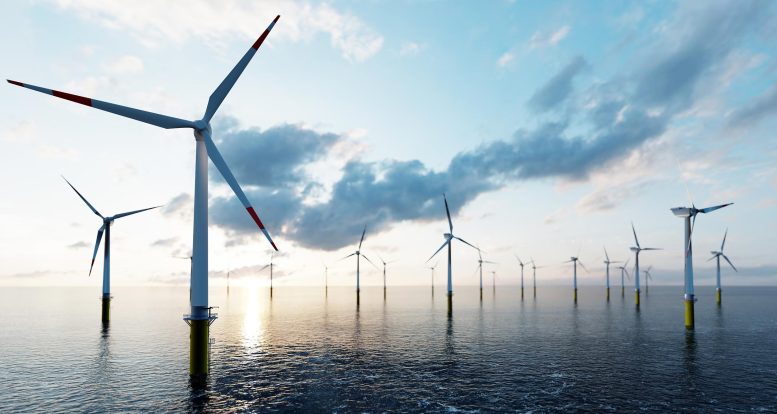
Offshore Wind Farm
A newly published study from Stanford scientists details the advanced weather model they developed, showing that there is plenty of wind to provide half the world’s power by 2030 and potentially exceed the total demand by several times if enough turbines are in place.
If the world is to shift to clean energy, electricity generated by the wind will play a major role – and there is more than enough wind for that, according to new research from Stanford and the University of Delaware.
Researchers at Stanford University’s School of Engineering and the University of Delaware developed the most sophisticated weather model available to show that not only is there plenty of wind over land and near to shore to provide half the world’s power, but there is enough to exceed the total demand by several times, even after accounting for reductions in wind speed caused by turbines.
The findings were published in the Proceedings of the National Academy of Sciences (PNAS) by Mark Z. Jacobson, a professor of civil and environmental engineering at Stanford, and Cristina Archer, an associate professor of geography and physical ocean science and engineering at the University of Delaware.
High-resolution models
In their study, Jacobson and Archer adapted the three-dimensional, atmosphere-ocean-land computer model known as GATOR-GCMOM to calculate the theoretical maximum wind power potential on the planet, taking into account wind reduction by turbines. Their model assumed wind turbines could be installed anywhere and everywhere, without regard to societal, environmental, climatic or economic considerations.
The new paper contradicts two earlier studies that said wind potential falls far short of the aggressive goal because each turbine steals too much wind energy from other turbines, and that turbines introduce harmful climate consequences that would negate some of the positive aspects of renewable wind energy.
The new computer model provides a more sophisticated look than previously possible by separating winds in the atmosphere into hypothetical boxes stacked atop and beside one another. Each box has its own wind speed and weather. In their model, Jacobson and Archer exposed individual turbines to winds from several boxes at once, a degree of resolution earlier global models did not match.
“Modeling the climate consequences of wind turbines is a complex science,” said Jacobson. “This software allows that level of detail for the first time.”
The researchers were able to calculate the exposure of each wind turbine in the model to winds that vary in space and time. Additionally, the model accounts for the wind that gets claimed by the turbines. It then calculates the effect of these wind speed changes on global temperatures, moisture, clouds, and climate.
Potential aplenty
Among the most promising things the researchers learned is that there is a lot of potential in the wind – hundreds of terawatts. At some point, however, the return on building new turbines would plateau, reaching a level in which no additional energy could be extracted even with the installation of more turbines.
“Each turbine reduces the amount of energy available for others,” Archer said. The reduction, however, becomes significant only when large numbers of turbines are installed, many more than would ever be needed.
“And that’s the point that was very important for us to find,” Archer said.
The researchers have dubbed this point the saturation wind power potential. The saturation potential, they say, is more than 250 terawatts if we could place an army of 100-meter-tall wind turbines across the entire land and water of planet Earth. Alternatively, if we placed them only on land (minus Antarctica) and along the coastal ocean, there is still some 80 terawatts available – about seven times the total power demand of all civilization. Hypothetical turbines operating in the jet streams 6 miles (9.6 kilometers) up in the atmosphere could extract as much as 380 terawatts.
“We’re not saying, ‘Put turbines everywhere,’ but we have shown that there is no fundamental barrier to obtaining half or even several times the world’s all-purpose power from wind by 2030. The potential is there, if we can build enough turbines,” said Jacobson.
How many?
Knowing that the potential exists, the researchers turned their attention to how many turbines would be needed to meet half the world’s power demand – about 5.75 terawatts – in a 2030 clean-energy economy. To get there, they explored various scenarios of what they call the fixed wind power potential – the maximum power that can be extracted using a specific number of wind turbines.
Archer and Jacobson showed that 4 million turbines, each operating at a height of 100 meters and producing 5 megawatts, could supply as much as 7.5 terawatts of power – well more than half the world’s all-purpose power demand – without significant negative affect on the climate.
“To get there, however, we have a long way to go. Today, we have installed a little over 1 percent of the wind power needed,” Jacobson said.
Jacobson and Archer would site half of the 4 million turbines over water. The remaining 2 million would require a little more than one-half of 1 percent of the Earth’s land surface – about half the area of the state of Alaska. However, virtually none of this area would be used solely for wind, but could serve dual purposes such as open space, farmland, ranchland or wildlife preserve.
Rather than put all the turbines in a single location, Archer and Jacobson say it is best and most efficient to spread out wind farms in high-wind sites across the globe – the Gobi Desert, the American plains and the Sahara, for example.
“The careful siting of wind farms will minimize costs and the overall impacts of a global wind infrastructure on the environment,” said Jacobson. “But, as these results suggest, the saturation of wind power availability will not limit a clean-energy economy.”
Reference: “Saturation wind power potential and its implications for wind energy” by Mark Z. Jacobson and Cristina L. Archer, 10 September 2012, Proceedings of the National Academy of Sciences.
DOI: 10.1073/pnas.1208993109
Funding sources for this research include the National Science Foundation, the U.S. Environmental Protection Agency, and the National Aeronautics and Space Administration (NASA) High-End Computing Program.








If these turbines are so good, then why are there so many people who live near them against them? Documenting the positive side is only half the picture. I like the Idea of off shore wind farms, but here in Ontario Canada(Land of the great lakes) they are all being erected in rural, but populated areas.
Perhaps; but where would we live? so much of the surface would be covered by these turbines.
All things considered, this is a stupid idea. Yes there are areas where it would work but as an energy policy it is doomed to failure.
Go dig coal, mine for uranium, and drill for oil and gas. Do now and do it all.